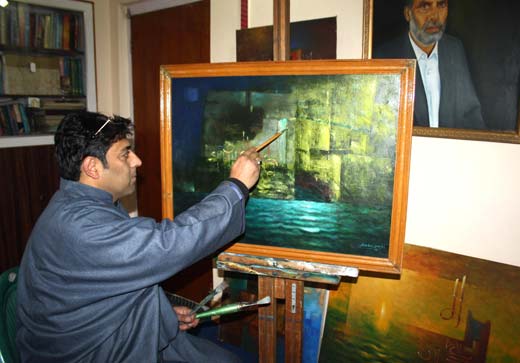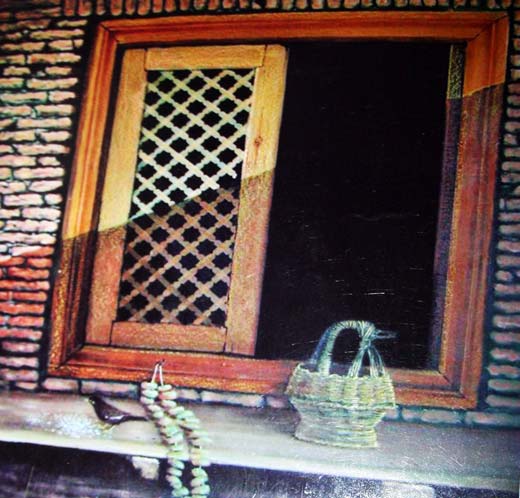What started from his father’s Paper Machie workshop where he used to play with colours as a kid turned into a career for Arshad Souleh. Syed Asma profiles the artist whose landscapes, Quranic calligraphy, portraits and figurative paintings adore walls across globe

Art is not to be explained, neither do its lovers like it to be explained as they do not want it to get confined to a particular thought, says an award-winning painter of Kashmir, Arshad Souleh.
He believes art was never a common man’s cup of tea. It always had a distinctive audience with high aesthetic sense and definitely gets its due appreciation if it is worth it.
A resident of Hawal, Souleh was born in Fateh Kadal, Srinagar in a family of a Paper Machie artisan, Mirza Mohammed Souleh Beigh. Beigh passed away about two months back at the age of 76.
Sitting besides an oil portrait of his father painted in 1994, Souleh owes his success to him. Donning a pheran of his late father he says, “I wouldn’t be what I am presently if I would have been born in any other family of Kashmir.”
Following a pause he adds with a charming smile, “Wearing his (His father’s) pheran makes me confident and makes me feel his presence.”
Creator of hundreds of beautiful landscapes, portraits, Quranic calligraphies and figurative paintings the forty-one-year-old Souleh is an extremely humble, modest and sensitive a person.
His sensitivity is depicted through his work. Be it ‘black moon’, ‘bitter honeymoon’, ‘mother encaged’, ‘love encaged’, ‘anxious couple’, ‘pathos’, ‘waiting for solution’ and ‘waiting for peace’, all have dark and harsh colours in it. “I had to (use dark colours)!” Souleh asserts, “I could not think of anything else but pain in past two decades.”
Most of these paintings won awards. The dark and harsh shades depict pain, bloodshed, grim faces, he says. Introducing himself, he says, “I am a super-sensitive person. I easily get affected by pain, so, killings, disclosure of secrets of my mothers and sisters disturbed me from within. The same was reflected in my work.”

Souleh believes an artist can’t pretend. His work reflects the society he lives in. “In my case turmoil was all over me.”
But presently Souleh is trying to get away with dark shades and is trying to induce an element of ‘hope’ through his work.
Not a talkative person, Souleh is often caught in deep thoughts. It seems he is always staring at the farthest things in his sight. “I never stare,” he smiles, “I am just thinking…about anything and everything.”
“Beauty inspires me,” says the artist. Wandering, meeting people, reading Persian, Kashmiri, Urdu and English literature besides listening to music helps him to create master pieces on canvas. In Persian he loves to read Maulana Rumi, Hafiz Sheerazi, Firdausi (Ferdowsi) and Mirza Ghalib.
All his paintings are well-researched and self-explanatory. Getting inspired from the work of an Iranian artist, whose name he doesn’t know, displayed in Iran Culture House, Delhi, Souleh started painting Quranic calligraphy after 1994.
But he played innovative. He started painting Quranic calligraphy combined with Kashmir’s beautiful landscapes. Not learning calligraphy, he feels he has inherited it from his grandfather, Hakim Akbar Ali, a well-known calligraphist of his times.
The first verse he painted was In nal la ha wamala ikatu hu usabi u nan Nabi. The letter bay in Nabi (SAW) is given a shape of boat as Souleh thinks Prophet (SAW) is a boat of salvation which on boarding helps to cross any ocean.
Similarly, in his other Quranic paintings he has played with letters. Letter bay is a boat in one and a bridge in another. Letter noon is painted in a way as is depicts a man holding arms high in the air while surrendering to Allah. Dots of letters are either depicted as sun or moon.
These paintings apart from Kashmir are mostly sold out in Saudi-Arabia, Pakistan and Canada but now Souleh says, to increase the audience he has improvised on it a bit. “Like European artists preach Christianity through their work, I as Muslim too want to preach my religion to a larger audience, so I am planning to combine abstract art with calligraphy,” Souleh says.
He is planning to work on this idea in a workshop in Hyderabad and know the feedback of people.
Working on innovative ideas Souleh wants to be relevant with the contemporary times, he does not want to be named as an orthodox artist, he says.
His every single painting is worth thousand words and Souleh has an explanation for every single object, its placement, colour painted in his work.
He while explaining his work and life extensively quotes Quran and Allama Iqbal. An artist, any creative man, needs to be a well-read person, Souleh believes.
Starting sketching and painting when he was five, Souleh joined the Institute of Music and Fine Arts, Rajbagh in 1992 and specialized in painting. Till now an amateur painter got a proper track to follow. After a year he started working as a professional artist and started participating in Kashmir based and other exhibitions.
 Steadily, his work started getting appreciated and presently he is counted among the best contemporary artists of India.
Steadily, his work started getting appreciated and presently he is counted among the best contemporary artists of India.
Since childhood blank spaces would attract him, he says, “Big walls, empty roads, notebooks, my legs and hands, I have painted on all of them,” he says laughing.
Being a son of a Paper Machie artist who ran a few workshops at his place helped Souleh as an artist; he never fell short of material! As a child he used to steal colours in bulk from his father’s workshop and instead of canvas used to collect a dozen of white cardboard scraps from local fabric shops.
Attending school during day, Souleh used to paint on holidays and during nights. Probably following the same habit of sleeping for fewer hours since childhood, his eyes always look tired and red.
Having many accolades to his name, local, national and international, he so far has attended two international exhibitions, 25 National exhibitions and has organised 13 solo exhibitions of his work.
In 2002, he was invited in an exhibition by the Ministry of Heritage and Culture in the Islamic Republic of Iran in which 25 countries across the globe had participated. “Impressed with my craft, the then Iranian President Syed Muhammed Khatimi personally met me and congratulated me for my work. That was a big achievement for me,” says Souleh.
Souleh’s work is displayed across globe. It is seen in America, Europe, Saudi Arabia and Pakistan. “About 6000 reproductions of my work are present in America,” he claims.















